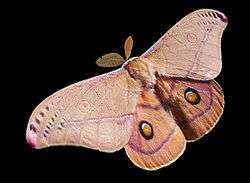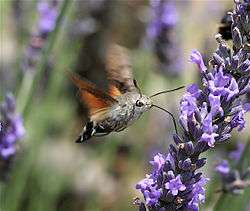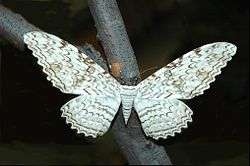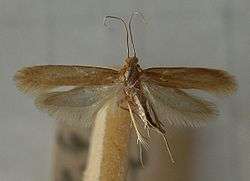Wikijunior:Bugs/Moth
< Wikijunior:Bugs

What does it look like?
Moths are flying insects with wings, similar to butterflies. Some moths have very large wings. There are some moths that do not have wings such as the female gypsy moth. The wings of a moth are covered with tens of thousands of tiny wing scales which overlap like shingles on a roof. Most moths are dull colors such as gray and brown. Moths often have antennae that look like feathers.

Where does it live?
Moths and their larvae can be found almost everywhere including: wetlands, temperate forests, mountains, deserts, rain forests, grasslands and even Arctic regions. There is even a moth that lives in the fur of South American sloths!
What does it eat?
Moth larvae eat all sorts of plants but each kind of moth only will eat one or a few different plants. Adult moths, mostly active at night, will drink the nectar of night blooming flowers and even the sap that leaks from a tree (after it gets damaged). There are moths that eat clothing.

How does it defend itself?
Moths and their larvae defend themselves in various ways. Some have an unpleasant taste to birds or mammals. Moth larvae can be covered with irritating 'hairs' or spines. Some of these spines can sting. When a predator tries to eat the caterpillar, some of the 'hairs' can come off when leaving the predator with a mouthful of tasteless fuzz! Some caterpillars are just plain scary-looking (Hickory-horned-devil!) Most moths are active at night and so hide during the day, away from predators. Bats consider night-flying moths quite delicious. Some moths are able to 'trick' bats by hearing/detecting their approach and then taking evasive actions. Camouflage is another way that moths defend themselves. The colors of some moth's wings help the moth to blend into its surroundings. Predators are unable to see the moth and so the moth survives. Some moths have large spots on their wings that look like eyes. If a predator such as a bird sees the moth, it attacks what it thinks are the moth's eyes. However it has merely pecked at the wing and the moth can escape with its head in one piece.
What stages of metamorphosis does it go through?
All of them: egg, larva, pupa and adult phases. The larvae grow from a tiny caterpillar to a much larger caterpillar and may shed its skin as it grows up to five times!
What special behavior does it exhibit?
Moths are attracted to bright lights. Some moths are active during the day. That is why you always see them gathered around street lights, porch lights, flames, etc.
How does this bug affect people?
Some moths lay eggs in clothing. Others lay them in dry food, like flour or rice. When the eggs hatch, the larvae will then eat the clothing or dried food. In the same way, larvae have damaged crops, trees and ornamental plants. Have you ever found strange holes in your clothes? They might have been made by a hungry moth larva!
Humans use mothballs to keep moths out of their clothing. Mothballs are round, white balls treated with chemicals that poison moths. Since the poison may also harm humans, the balls should never be tasted or eaten. You should wash your hands immediately after touching mothballs.
At the same time, moths also do things which help people. For example, moths help flowers grow by pollinating them. The downside of this is that the moths also lay their eggs in the leaves of the plant. When the eggs hatch into caterpillars, the munching of the plant begins! Have you ever seen the holes that caterpillars make as they chew on the leaves of plants?